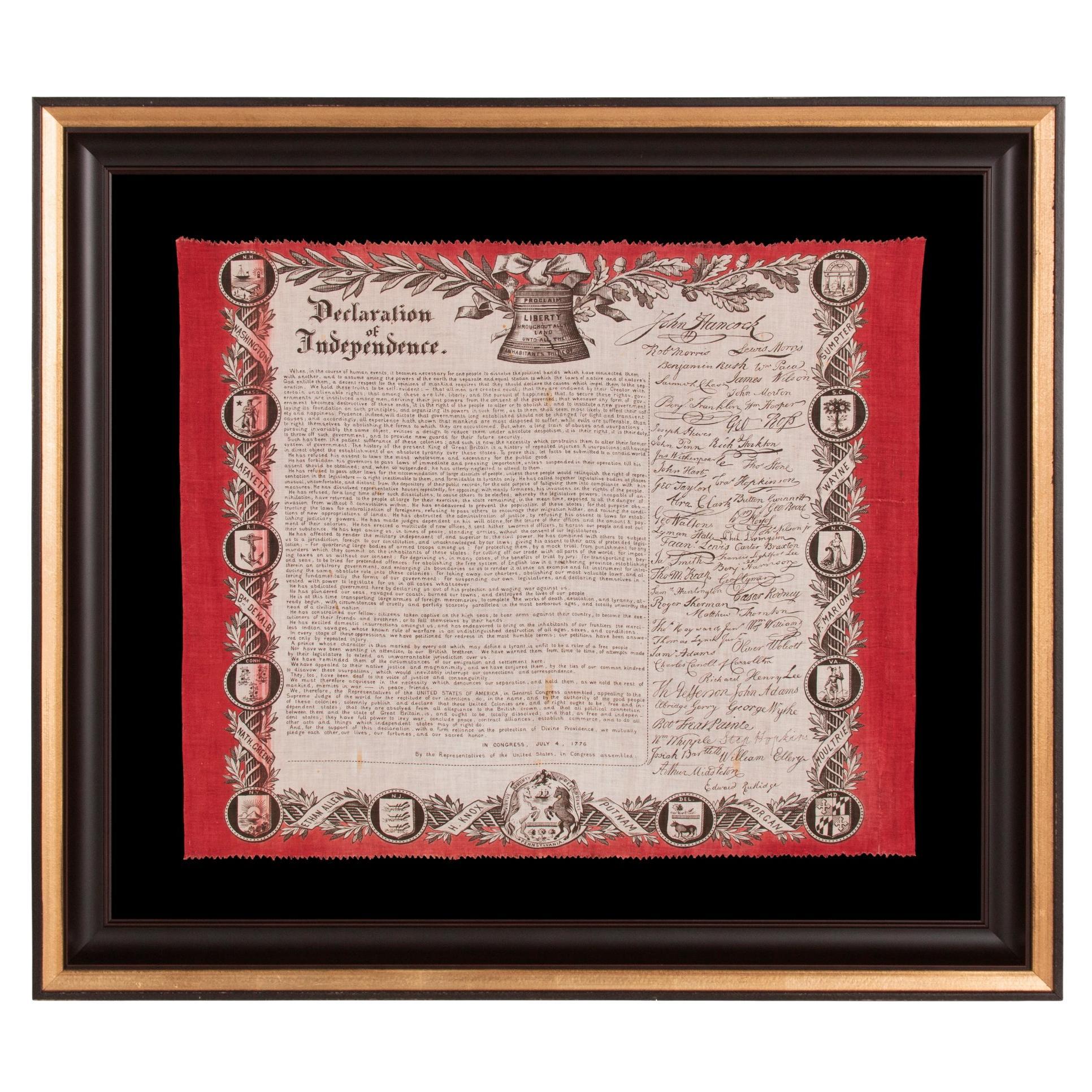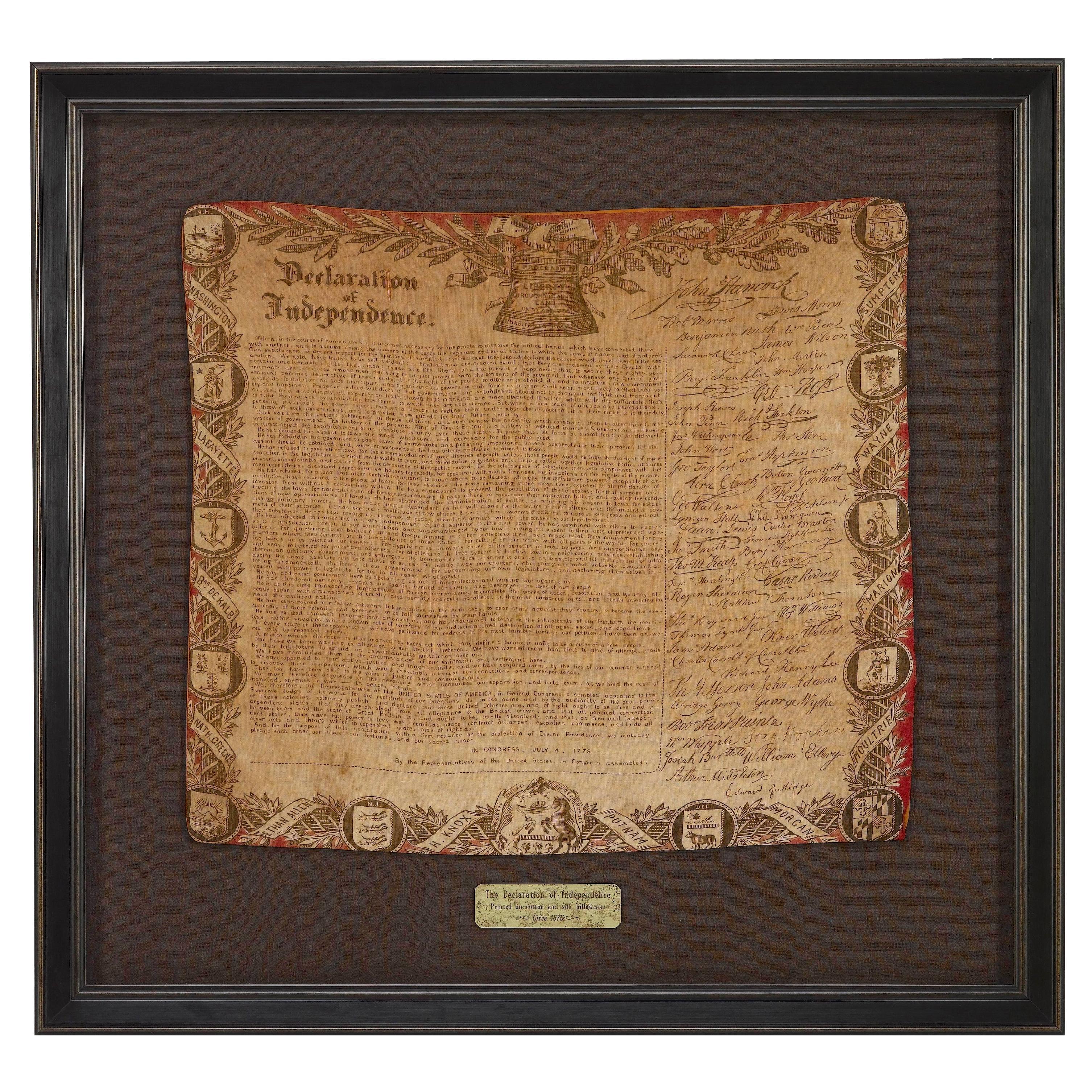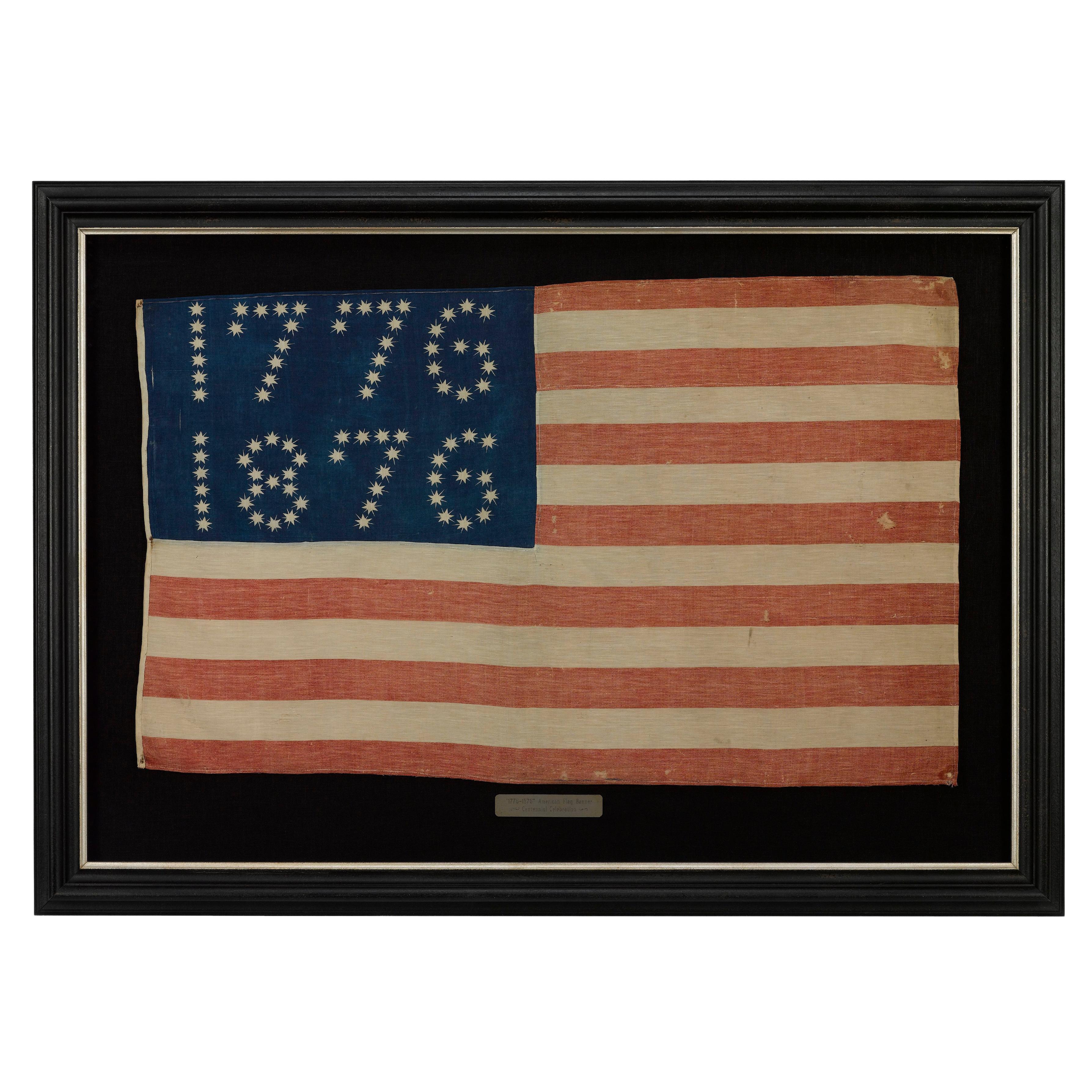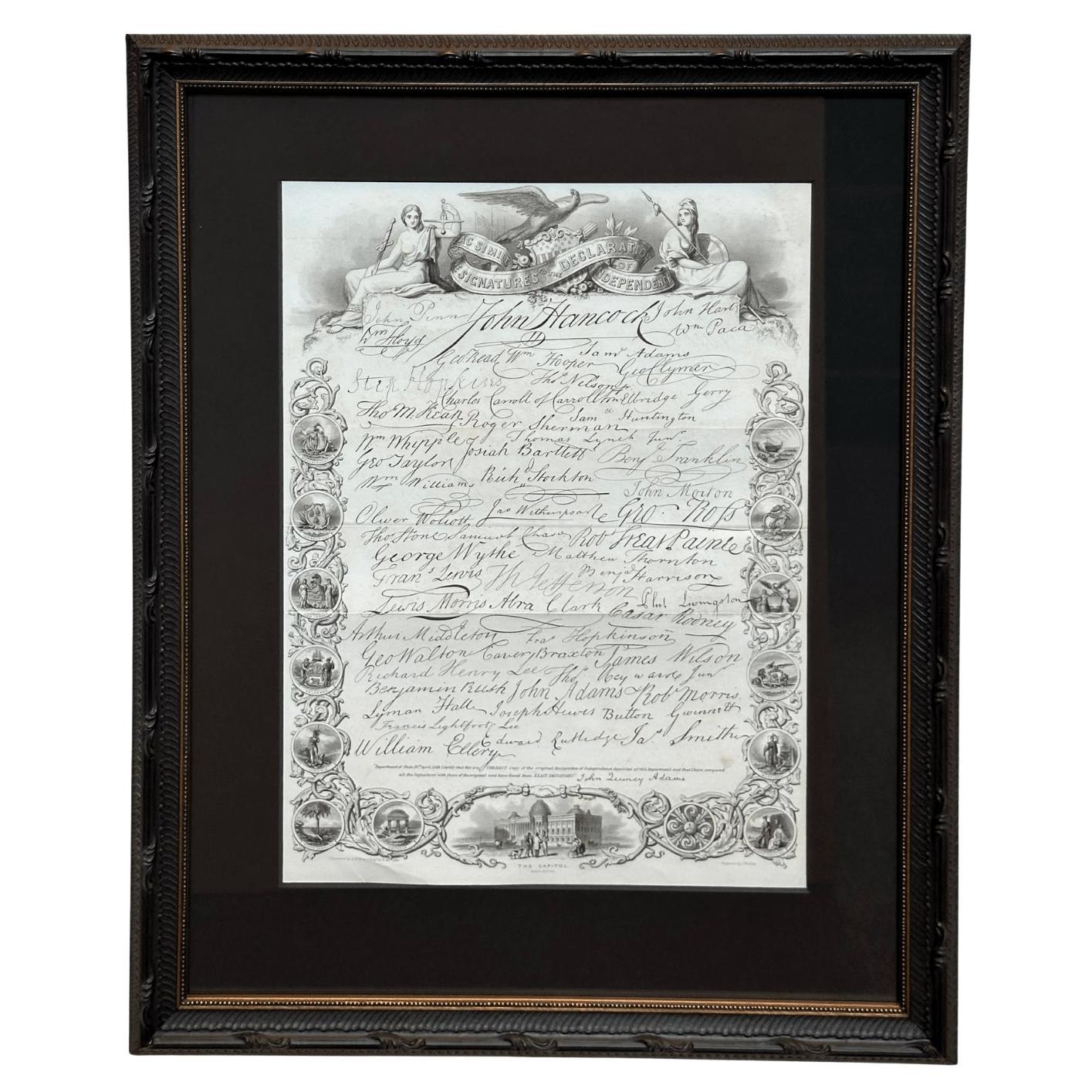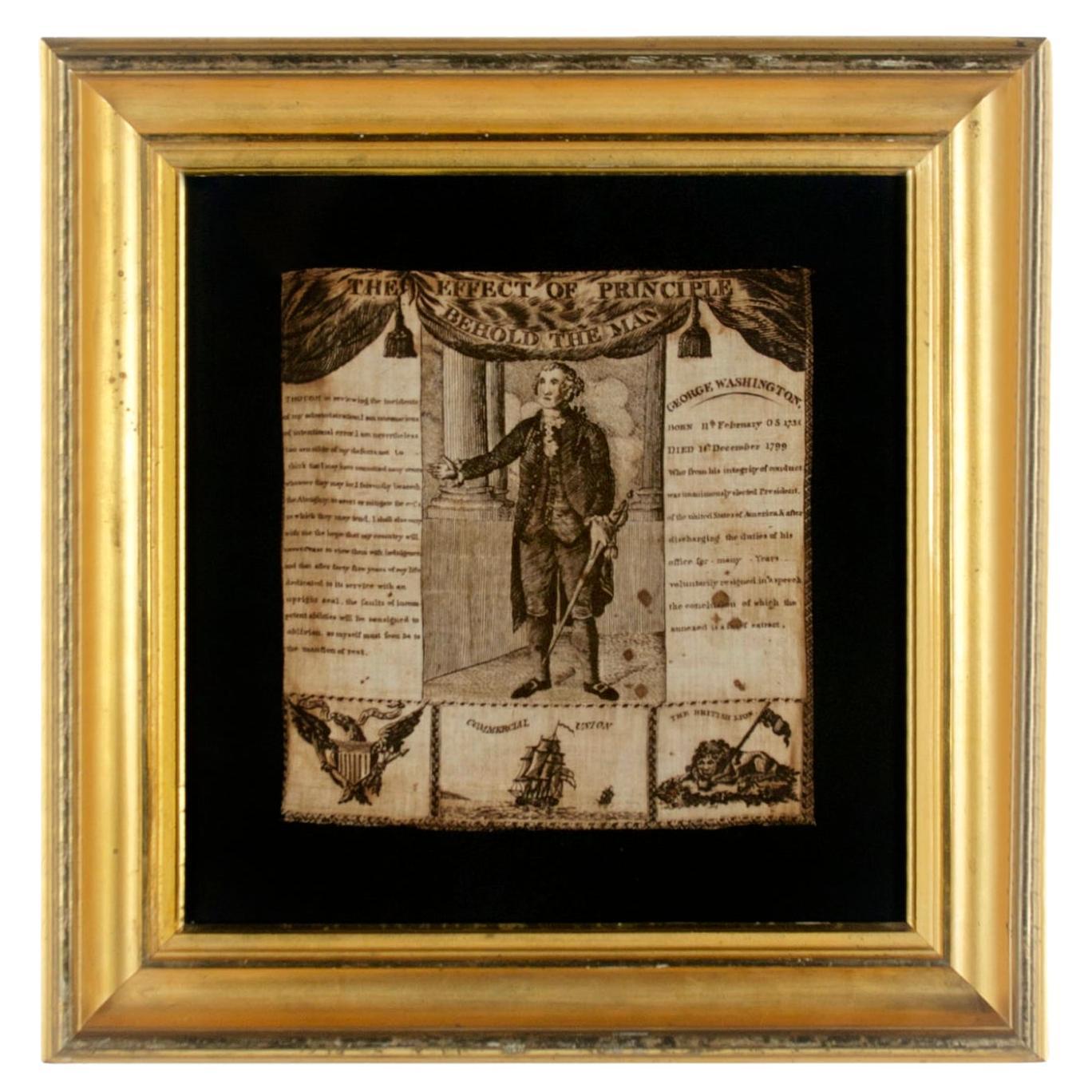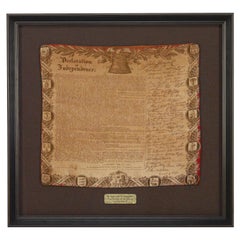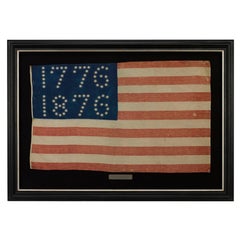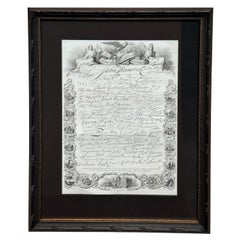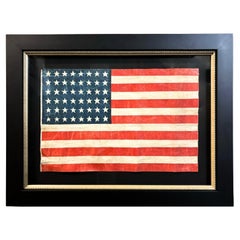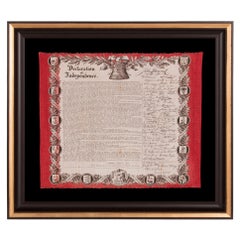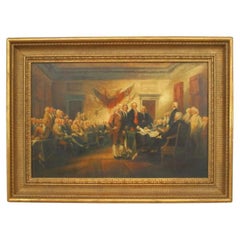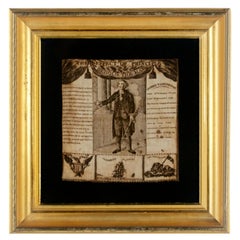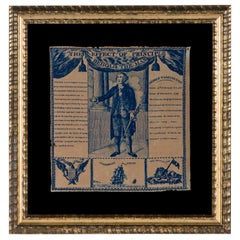Items Similar to Declaration of Independence Printed Scarf
Video Loading
Want more images or videos?
Request additional images or videos from the seller
1 of 10
Declaration of Independence Printed Scarf
$2,000
£1,520.68
€1,751.84
CA$2,843.47
A$3,090.37
CHF 1,633.14
MX$37,386.78
NOK 20,339.58
SEK 19,211.99
DKK 13,079.50
About the Item
Presented is a patriotic silk scarf, celebrating the Declaration of Independence. At center of the silk scarf design is artistic rendering of the Declaration of Independence. The famous text and signatures are printed in black ink on white silk. A border of bright red encloses the text, with a five-pointed white star set against a blue square appearing at each corner. This is a newly made silk scarf, printed to celebrate our Nation's foundational text.
The United States Declaration of Independence was adopted by the Second Continental Congress at the Pennsylvania State House in Philadelphia, on July 4, 1776. Enacted during the American Revolution, the Declaration explains why the thirteen colonies at war with the Kingdom of Great Britain regarded themselves as thirteen independent sovereign states, no longer subject to British colonial rule. The Declaration of Independence was signed by 56 of America's Founding Fathers, congressional representatives from New Hampshire, Massachusetts, Rhode Island, Connecticut, New York, New Jersey, Pennsylvania, Maryland, Delaware, Virginia, North Carolina, South Carolina, and Georgia. With the Declaration, these new states took a collective first step in forming the United States of America and, as a result, formalized the American Revolutionary War.
CONDITION:
Overall very good condition. Printed silk. Hand-rolled hems are intact, tight and round. Silk and colors are fresh and vibrant.
Beautifully presented using the finest archival materials and procedures. The scarf is mounted in a custom-built gold frame. Framed Dimensions: 32 1/2" H x 32 1/2" W x 2 1/2" D.
- Dimensions:Height: 32.5 in (82.55 cm)Width: 32.5 in (82.55 cm)Depth: 2.5 in (6.35 cm)
- Materials and Techniques:
- Place of Origin:
- Period:
- Date of Manufacture:21st Century
- Condition:Additions or alterations made to the original: Mounted and framed to the highest archival standards by Art Source International Framing, in Boulder, Colorado, in October of 2022.
- Seller Location:Colorado Springs, CO
- Reference Number:Seller: OT5561stDibs: LU909731823522
About the Seller
4.9
Platinum Seller
Premium sellers with a 4.7+ rating and 24-hour response times
Established in 2010
1stDibs seller since 2011
465 sales on 1stDibs
- ShippingRetrieving quote...Shipping from: Colorado Springs, CO
- Return Policy
Authenticity Guarantee
In the unlikely event there’s an issue with an item’s authenticity, contact us within 1 year for a full refund. DetailsMoney-Back Guarantee
If your item is not as described, is damaged in transit, or does not arrive, contact us within 7 days for a full refund. Details24-Hour Cancellation
You have a 24-hour grace period in which to reconsider your purchase, with no questions asked.Vetted Professional Sellers
Our world-class sellers must adhere to strict standards for service and quality, maintaining the integrity of our listings.Price-Match Guarantee
If you find that a seller listed the same item for a lower price elsewhere, we’ll match it.Trusted Global Delivery
Our best-in-class carrier network provides specialized shipping options worldwide, including custom delivery.More From This Seller
View AllDeclaration of Independence, Printed on Cotton, Circa 1876
Located in Colorado Springs, CO
Presented is a Centennial-era patriotic textile, celebrating the Declaration of Independence. At the center of the printed bandana design is artistic rendering of the Declaration of ...
Category
Antique 1870s American High Victorian Political and Patriotic Memorabilia
Materials
Cotton
Centennial Celebration "1776-1876" American Flag Banner
Located in Colorado Springs, CO
Presented is a rare Centennial patriotic flag banner, dating to 1876. The flag’s brilliant blue canton is spectacular, with 81 five-pointed, rayed stars, arranged to read “1776” and “1876.” The flag’s design is completed with thirteen alternating red and white stripes. The flag is a three-piece, treadle-sewn sewn construction, printed on a thin wool and cotton blend. Along the edge, there is a narrow, treadle-sewn sleeve made of cotton tape.
In the lead up to the nation’s Centennial in 1876, flag makers and individuals looked to the past for designs to produce as part of the country’s many celebrations. Popular interpretation of the stars and stripes undoubtedly reached its climax of variety and originality at the time of our Nation’s first Centennial. Since no design restrictions were placed on flagmaker’s imaginations and no strict distinctions were drawn between official and unofficial star counts, it is no surprise that, on the occasion of the Centennial, creativity in flag design was not the exception, but the rule.
The cantons from this period presented an array of geometric abstractions. Great star patterns, referred to as the “starry flower of Liberty” by Oliver Wendell Holmes, that were popular from 1818 and on, resurfaced in Centennial flags...
Category
Antique 1870s American Political and Patriotic Memorabilia
Materials
Wool, Cotton
"Facsimile of the Signatures to the Declaration of Independence" by A.H. Wray
Located in Colorado Springs, CO
Presented is a handsome steel engraving, a patriotic composition of the facsimile signatures of the signers of the Declaration of Independence. The engraving is from John H. Hinton’...
Category
Antique 1850s American Federal Prints
Materials
Paper
48-Star Printed American Flag, Commemorating Arizona Statehood, 1912-1958
Located in Colorado Springs, CO
This is an original 48-star American parade flag, celebrating Arizona statehood. A wonderful product of our nation's early history, this flag is an authentic antique, with a fly date...
Category
Mid-20th Century American Political and Patriotic Memorabilia
Materials
Fabric
31-Star Printed American Flag, Celebrating California Statehood, Circa 1850
Located in Colorado Springs, CO
This is a rare 31-star medallion printed American flag, celebrating the addition of California to the Union. The flag is printed on silk and has a spectacular “Great Star” canton pat...
Category
Antique 1850s American Political and Patriotic Memorabilia
Materials
Silk
45-Star American Flag, Printed on Cotton, Celebrating Utah Statehood, 1896-1908
Located in Colorado Springs, CO
This 45-star United States flag celebrates the statehood of Utah. 45-star flags served as the official American flag from 1896-1908. This particular flag was flown as a parade flag. ...
Category
Antique 1890s American Political and Patriotic Memorabilia
Materials
Cotton
You May Also Like
The Declaration of Independence, Printed on Cotton, ca 1876
Located in York County, PA
PRINTED COTTON KERCHIEF GLORIFYING THE DECLARATION OF INDEPENDENCE, WITH TEXT AND REPRODUCED SIGNATURES, MADE FOR THE 1876 CENTENNIAL INTERNATIONAL EXPOSITION IN PHILADELPHIA
Printed on cotton, this beautiful kerchief pays homage to the Declaration of Independence, through the reproduction of its text and 56 signatures, surrounded by a fanciful border. The latter contains the 13 state seals, which are dispersed around the perimeter in small medallion images. Note how Pennsylvania is highlighted among them, larger and in the bottom center, both because it served as the meeting place of the Second Continental Congress, and played host to the 1876 Centennial International Exposition, the six-month long World’s Fair event that was held in honor of our nation’s 100-year anniversary of independence.
The names of twelve Revolutionary War generals are spread out between each crest, on each forward-facing turn of a scroll, that wraps around the pillar and leaf border on the right, left, and bottom. These include Washington, Lafayette, Johann de Kalb, Nathiel Greene, Ethan Allen, Henry Knox, Israel Putnam, Daniel Morgan, William Moultrie, Francis Marion...
Category
Antique Late 19th Century American Political and Patriotic Memorabilia
Materials
Cotton
Price Upon Request
Declaration of Independence Signing Painting
Located in Queens, NY
Copy of painting titled "Declaration of Independence" John Adams, Robert Sherman, Thomas Jefferson (presenting the document), and Benjamin Franklin--standing before John Hancock
Category
Late 20th Century American Victorian Paintings
Materials
Paint
Printed Linen Kerchief of George Washington, ca 1806, Germantown, PA
Located in York County, PA
Extraordinarily early (1806) printed linen kerchief glorifying George Washington, Germantown print works, Germantown, Pennsylvania
Printed in sepia ink on coarse, white linen, this patriotic kerchief shows a standing portrait of George Washington, above which is a swag valance and the words “The Effect of Principle, Behold the Man”. The portrait is based on a mezzotint after Gilbert Stuart’s very famous painting of Washington in his later years. Stuart painted it in oil on canvas for a wealthy merchant by the name of William Constable, who commissioned the work for Alexander Hamilton.
The kerchief is interesting because it is both American-made and documented. This is exceptionally unusual for any printed textile of the 19th century or prior and the earlier the time period the more unlikely an object is to be identified. This kerchief and a companion piece entitled “The Love of Truth Mark the Boy” (also glorifying Washington through the fabled story of the cherry tree), were made ca 1806 by Germantown Print Works in Germantown, Pennsylvania.
To the left of Washington's image is a portion of his infamous farewell address to his troops at the end of the Revolutionary War. To the right is a short excerpt from his eulogy. Below these are three images. In the center is a square-rigged tall ship with “Commercial Union” above it, flanked by the American eagle on the left and the British lion...
Category
Antique Early 19th Century American Political and Patriotic Memorabilia
Materials
Linen
1806 Printed Linen Kerchief Glorifying George Washington, Germantown, Penn
Located in York County, PA
EXTRAORDINARILY EARLY (1806) PRINTED LINEN KERCHIEF GLORIFYING GEORGE WASHINGTON, PRINT WORKS, GERMANTOWN, PENNSYLVANIA
Printed in blue ink on coarse, white linen, this patriotic kerchief shows a standing portrait of George Washington, above which is a swag valance and the words “The Effect of Principle, Behold the Man”. The portrait is based on a mezzotint after Gilbert Stuart’s very famous painting of Washington in his later years, most often referred to as the Landsdowne portrait. Stuart painted three versions of it in oil on canvas, one of which was completed in 1796 for a wealthy merchant by the name of William Constable, who commissioned the work for Alexander Hamilton.
The kerchief is interesting because it is both American-made and documented. This is exceptionally unusual for any printed textile of the 19th century or prior and the earlier the time period the more unlikely an object is to be identified. This kerchief and a companion piece entitled “The Love of Truth Mark the Boy” (also glorifying Washington, through the fabled story of the cherry tree), were made circa 1806 by Germantown Print Works in Germantown, Pennsylvania.
To the left of Washington's image is a portion of his infamous farewell address to his troops at the end of the Revolutionary War. To the right is a short excerpt from his eulogy. Below these are three images. In the center is a square-rigged tall ship with “Commercial Union” above it, flanked by the American eagle on the left and the British lion on the right. It is reasonable to assume that the textile may have been produced in demonstration of the maker's desire, and/or that of others, to advance trade with England. Commercial printers were very influential in early America, as they possessed the means by which to disseminate information.
This kerchief and its companion piece are documented in Threads of History, Americana Recorded on Cloth, 1775 - the Present, by Herbert Ridgeway Collins (1979, Smithsonian Press), p. 63, items 38 & 39.* The two pieces pictured are in the collection of Cornell University, but the Collins text also cites an uncut pair to be present in the collection of the Western Reserve Historical Society, Cleveland, OH. The name "Germantown Print Works" is printed on the Western Reserve examples. Another example of the textile in question is documented in "Running for President, The Candidates and Their Images, 1789-1896" by Schlesinger, Israel, and Frendt, (1994, Simon & Schuster), p. 15.
I have seen three different color variations of this textile, including sepia, mulberry red, and blue. This particular example has a hand-sewn binding along the top, lower, and left edges.
Mounting: The textile was mounted and framed within our own conservation department, which is led by expert staff. We take great care in the mounting and preservation of flags and have framed thousands of examples.
The gilded molding has a rippled profile and dates to the period between 1825 and 1850.The background is 100% cotton twill, black in color. The glazing is U.V. protective plexiglass. Feel free to contact us for more details.
Condition: There is an all-over golden oxidation of the white fabric and there is very minor staining. There are tiny tack holes in each corner and there are minor nicks around the perimeter.
* Collins relates that Germantown Printworks was operated by the Hewsons. In doing so he cites one of Worthington Chauncey Ford's books on George Washington, but it isn't clear which one (there are many) and no page numbers are given. John Hewson was an Englishman who came to America and opened his printing business on the advice of Benjamin Franklin. He was one of the first “calico printers” and is the earliest documented to have advertised printed kerchiefs. His ads for bandanas appear as early as June 20th, 1774. He is suspected of having produced the very first American kerchief that pictured an American president, which is documented in Collins as item 1 on page 48. Linda Eaton, curator at Winterthur, in 2012, is currently doing in depth research on the three printers of fabrics that were operating in Germantown in early America. She discovered that the owner and/or operator of Germantown Print Works, while not currently known, was not John Hewson. This information is not yet published. She also noted that Winterthur possessed examples of the two George Washington textiles...
Category
Antique Early 1800s American Political and Patriotic Memorabilia
Materials
Cotton
Patriotic Flag Quilt Dated 1777
Located in Darnestown, MD
Although we think of the year 1776 as the time of the birth of the United States, it was actually not until 1777 that the Articles of Confederation were adopted by the Continental Co...
Category
Antique 1870s American American Colonial Quilts
Materials
Cotton
Homemade, Antique American Flag with Exceptional Folk Qualities, 1896-1908
Located in York County, PA
HOMEMADE, ANTIQUE AMERICAN FLAG WITH A TINY CANTON RESTING ON THE 6TH STRIPE AND AN EXTREMELY FOLKY PRESENTATION OF 45 STARS IN A “NOTCHED” PATTERN THAT MIGHT BE UNIQUE TO THIS EXAMP...
Category
Antique 1890s American Political and Patriotic Memorabilia
Materials
Cotton
More Ways To Browse
Harvest Tapestry
Kennedy Bahia
Pinton Freres
Romantic Scenes Tapestry
Tapestry The Hunt
Antique Silk Tapestry Persian
Bead Wall Hanging
Camel Tapestry
Dragon Tapestry
Marc Saint Saens
Raw Cotton Tapestry
Silkscreen Tapestry
Tapestry Perrot
Thai Tapestry
Tufted Wall Hanging
Vintage Indian Tapestry
1950s French Tapestry
Antique Gobelins Tapestry
